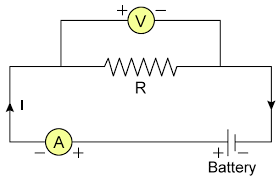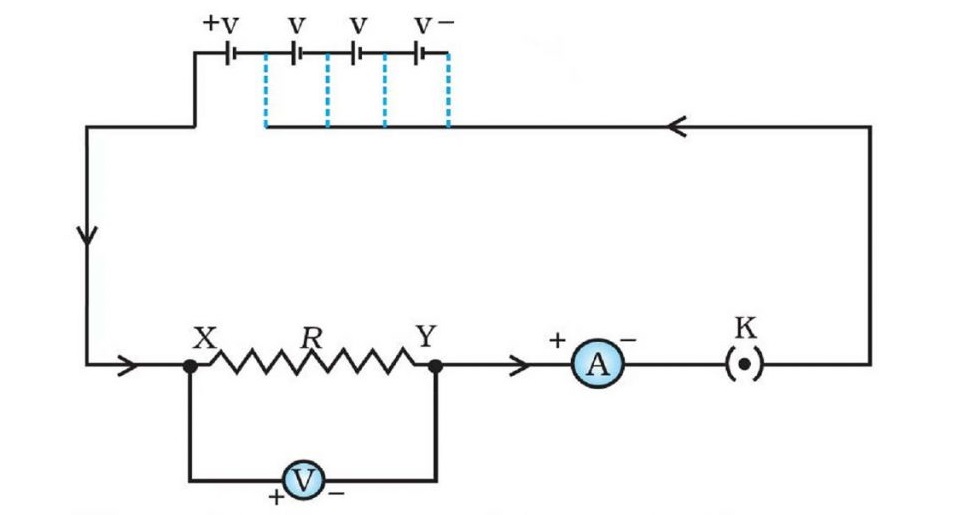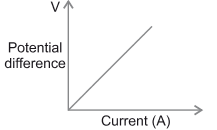Class 10 Electricity Notes
Notes Previous Years Questions Important QuestionsElectricity Notes
Charge(Q):-
Electric charge is the basic physical property of matter that causes it to experience a force when kept in an electric or magnetic field.
- It can be positive or negative.
- S.I. unit – Coulomb (C)
Quantisation of Charge:-
Every charge is an integral multiple of a basic charge i.e., charge on an electron(e–).
- Q=ne
- Number of electrons(n) = Q/e
- Charge on an electron (1e–) =1.6 x 10-19 C
Electric Circuit:-
A continuous and closed path of an electric current is called an electric circuit.

Electric current(I):-
The rate of flow of electric charge is called electric current.
- I = Q/t
- S.I. unit:- Ampere(A)
- Conventionally, the direction of flow of electric current is opposite to the direction of flow of electrons
- The amount of electric current in a circuit is measured by an instrument called ammeter.
- An ammeter is always connected in series in a circuit.
- 1 mA = 10-3 A & 1 µA = 10-6 A
1 Ampere:- The electric current flowing through a circuit is said to be 1 ampere when 1 coulomb of charge flows through it per second.
Electric Potential:-
The work done to move a unit charge from infinity to a point is known as electric potential of that point.
Electric Potential Difference:-
The work done to move a unit charge from one point to another point is called potential difference between the two points.
- V = W/Q
- S.I. unit:- Volt(V)
- Potential difference is measured by an instrument called voltmeter.
- Voltmeter is always connected in parallel across the points between which the potential difference is to be measured.
1 Volt:- The potential difference across the two points of a conductor is said to be 1 volt when 1 joule of work is done to move a charge of 1 coulomb from one point to the other.
Ohm’s Law:-
At constant temperature, the potential difference across the ends of a conductor is directly proportional to the amount of current flowing through it.
Mathematically,
V ∝ I
V = IR where, R is constant of proportionality & is known as resistance.
Circuit diagram and V-I graph for Ohm’s law:-
.

Resistance:-
The property of a conductor to oppose the flow of charges through it is called resistance.
- R = V/I
- S.I. unit:- Ohm (Ω)
1 Ohm:- The resistance of a conductor is said to be 1 Ω if the potential difference across the ends of a conductor is 1 V and the current flowing through it is 1 A.
Resistor:- A conductor having some appreciable resistance
Variable Resistance/Rheostat:- A component used to regulate current without changing the voltage source
Factors on which resistance of a conductor depends are:-
- its length (l)
- its cross-section area (A)
- nature of its material
Mathematically,
R ∝ l ——–(i)
R ∝ 1/A ——(ii)
On combining (i) & (ii):-
R = ρl / A where, ρ(rho) is constant of proportionality & is known as resistivity
Resistivity/Specific Resistance(ρ):-
The resistance of the conductor of unit length & unit area of cross section is called its resistivity.
- ρ =RA/l
- S.I. unit :- ohm meter (Ω m)
➢ On increasing the temperature, both resistance and resistivity of a conductor increases.
Resistors in Series:-
When two or more resistors are connected end to end to each other, then they are said to be connected in series.
In series combination,
- current flowing is same through each resistor.
- the potential difference across each resistor is different.
.
Consider current ‘I’ is flowing through the circuit & the potential difference across resistors R1, R2 & R3 be V1, V2, V3 respectively. Let the total potential difference be ‘V’ & equivalent resistance be ‘Rs‘.
On applying Ohm’s law,
V = IRs ; V1 = IR1; V2 = IR2 ; V3 = IR3
Now, V = V1 + V2 + V3
or, IRs = IR1 + IR2 + IR3
or, Rs = R1 + R2 + R3
Resistors In Parallel:-
When two or more resistors are connected together between two points then they are said to be connected in parallel.
In parallel combination,
- The potential difference is same across each resistor.
- The current flowing through each resistor is different.
.
Consider potential difference across the resistors be V & the current flowing through resistors R1, R2 & R3 be I1, I2 & I3 respectively. Let the total current flowing through the circuit be I & equivalent resistance be Rp.
By Ohm’s law,
I = V/Rp ; I1 = V/R1 ; I2 = V/R2 ; I3 = V/R3
Now, I = I1 + I2 + I3
or , V/Rp = V/R1 + V/R2 + V/R3
or , 1/Rp = 1/R1 + 1/R2 + 1/R3
Advantages of parallel combination over series combination:-
- In series combination, current remains same throughout the circuit while in parallel combination, current is different through each device and different components require different currents to operate properly.
- If one device fails in series circuit then none of the devices works while it will not happen in parallel circuit.
- The total resistance in a parallel circuit is decreased while the total resistance in series circuit is increased.
Electric Power:-
The amount of electrical energy consumed per unit time in an electric circuit is known as electric power.
P = W/t
Or, P = VQ/t
Or, P = VI = I2R = V2/R
- S.I. unit of power:- Watt(W)
1 Watt:- Electric power of an appliance is said to be 1 W if 1 A of current flows through it and the potential difference across its ends is 1 V.
Heating Effect of Electric Current:-
W = VQ =VIt
or H = VIt = I2Rt
Joule’s Law of Heating:-
According to Joule’s law of heating, heat produced in a resistor is directly proportional to
- square of current (H ∝ I2)
- resistance (H ∝ R)
- time for which current flows (H ∝ t)
H = I2Rt
- S.I. unit of energy:- Joule(J)
- Commercial unit of energy:- kilowatt hour(kW h)
Practical Applications of Heating Effect of Electric Current:-
Appliances based on heating effect of electric current are electric bulb, electric iron, electric toaster, electric oven, electric kettle, electric heater, fuse etc.
- Tungsten is used as the filament of the electric bulb.
- The bulbs are filled with chemically inactive gases like nitrogen and argon to prolong the life of the filament.
Conversion of Commercial Unit of Energy to S.I. Unit:-
1 kW h = 1000 W x 3600 s = 3.6 x 106 Ws = 3.6 x 106 J
1 unit = 1 kW h = 3.6 x 106 J


Comments
Saurabh singh
Thank you sir for the wonderful notes
Vikash Kumar
This notes cleared my doubts. Thank you sir.
Vinit Anand
What is the direction of electric current?
Kajal
Opposite to the direction of flow of electrons.
BLACK1SEVEN
Positive to negative
Herb Zmiejko
Yes, this is a Good one
Luna Manto
plant of API
Mughal Thakur
Wonderful notes sir.
I really like it.
vorbelutrioperbir
The following time I learn a weblog, I hope that it doesnt disappoint me as a lot as this one. I imply, I know it was my choice to learn, but I truly thought youd have something fascinating to say. All I hear is a bunch of whining about one thing that you may fix in case you werent too busy on the lookout for attention.
vorbelutrioperbir
I’d perpetually want to be update on new blog posts on this website , saved to my bookmarks! .
zoritoler imol
Nice post. I learn something more challenging on different blogs everyday. It will always be stimulating to read content from other writers and practice a little something from their store. I’d prefer to use some with the content on my blog whether you don’t mind. Natually I’ll give you a link on your web blog. Thanks for sharing.
vorbelutr ioperbir
Some truly nice and useful info on this website , too I think the pattern has got excellent features.